Beehive Inspection!
...

Today, Robb and I suited up, and took a look inside of one of our beehives. We had glanced inside the hives when we added the bees and comb that Taylor gave us, but we resisted the urge to look inside the hive every ten minutes, so as not to disturb the colony and the queen.
A hive inspection is pretty much like having a giant hand reach down from the heavens, rip apart the walls of your house, and then re-arrange all your furniture. This is, undoubtedly, stressful to the bees, so we opted to leave our young colony alone, to let them get settled.
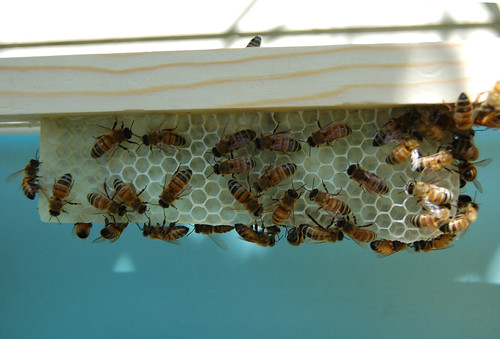
As far as we were concerned, things looked great. The bees were using the pieces of embossed wax "foundation" as a starting place for building their own comb. Robb and I are trying to let the bees make most of the decisions, because they're way better at understanding the needs and life-cycle of bees than we are.
We had heard a lot of anecdotal evidence that bees build their own comb more swiftly on these wax "starter strips" than on entire sheets of wax or plastic. (Of course, we'd also read the counter-argument that bees expend huge amounts of energy on building comb.) We figured that our method most closely replicated what bees would do in the wild. They find a hollow tree, and start building honeycomb. Seems simple to us. There are fewer worries about the beeswax used in our frames being contaminated by agricultural chemicals. Our bees' homes are not made of recycled beeswax from who-knows-where. The wax in our hives is newly manufactured, by the bees, themselves.
You get a great view of the process in the photo above. The bees have started using the wax strips as a guide for construction of their combs. The left side of the strip is what we gave the bees, and on the right, they're hard at work, building on the foundation of embossed wax.
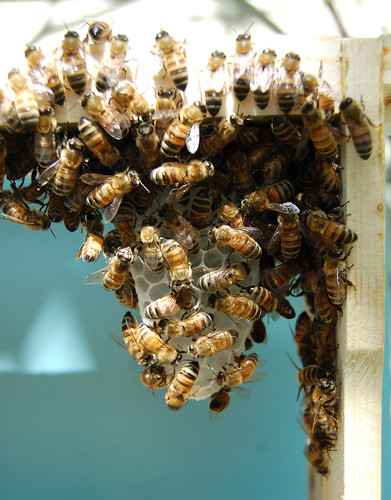
On the very same frame, the bees have already started building their own structures. This paddle-shape is typical construction.
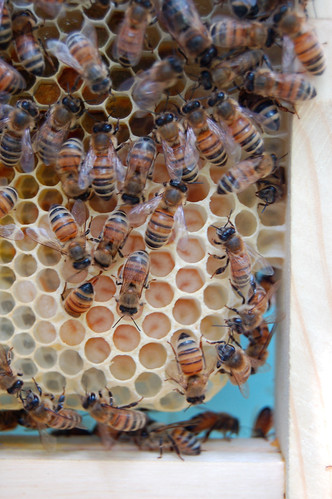
Here's what we had hoped to see: lots of big fat juicy larvae. (I never thought I'd ever say that, prior to inviting bees into my life!) The larvae are fed by the "nurse" bees, who are crawling all over the place. After the larvae molt four times, the nurse bees will seal them into their wax cells, and they will develop into pupae, and then into bees.

What we didn't see today was eggs. I have to admit that I got totally distracted by the bee in the center of the photograph. Not only did she have bright red pollen on her legs, but she was doing the "waggle dance" on top of the capped brood. (It's hard to stay focused when witnessing the waggle dance -- if you doubt this, ask any of my ex-boyfriends.)
Because I failed to look for eggs, I can't tell if we have a laying queen, or if all the larvae are from the eggs that came from Taylor's hive. The bees have not made any of the signs of manufacturing a new queen, which is what they'd be doing if we didn't have a queen. They're behaving in a very contented-seeing, methodical manner, which suggests that we are "queen right."

What wasn't so great, was this bit of comb that the bees were building on the bottom edge of three frames. This is a good illustration of the argument against foundation-less beekeeping. Because they had no pre-started frames of wax foundation, the bees opted to start building at a right angle to the comb on the top of the frames.
The style of hive that we're using is a lot like a hanging file folder, where the frame (the hanging files) can be removed from the box at any time. However, the bees had tied three frames together, and if they had started to raise brood in this comb, the brood cells would have been ripped apart the next rime I tried to remove a frame. I'm still squeamish about ripping apart larvae and pupae. It's all too maggotty for my sensibilities.
As I said, we plan to let the bees make most of the decisions, but in this case, we cut away this perpendicular comb, so that it wouldn't cause trouble later on.

Bees instinctively build their comb with consistent external spacing, which beekeepers refer to as "bee space." However, since the bees hadn't filled the hive box, this particular comb was being built at an irregular angle to the frame. It was also in peril of being ripped up in the course of future hive inspections. The newly formed wax is very malleable, and we just sort of smooshed it back into position. We'll see how this works out.
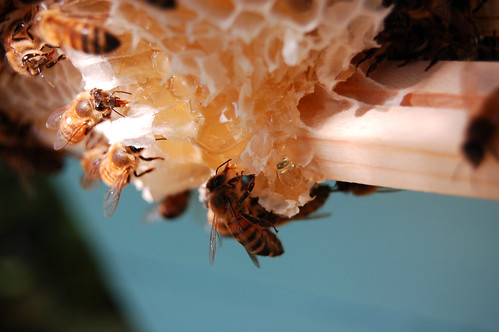
Our highly technical smooshing didn't seem to bother the bees. They slurped up the spilled nectar, and didn't fuss at all. Can you see the bees' tongues? Awesome.
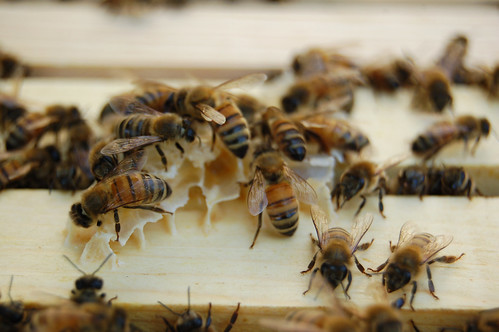
The only other bit of housekeeping that we did was to remove a bit more of this "burr comb" where the bees were trying to build a bridge between two layers of frames. Again, we did this to minimize damage later on.
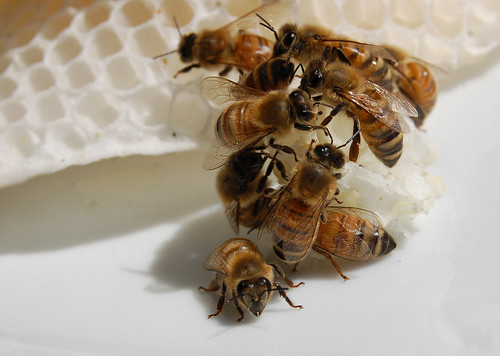
We set the honey-dripping wax out on a plate, and let the bees eat their fill. I still cannot get over the beauty of the newly-made wax.
Overall, the hive inspection was a success. Robb and I moved carefully, and with a purpose. We weren't stung, and we didn't seem to annoy the bees. We were happy with what we saw, and with how we handled the hive.
So far, so good!

Today, Robb and I suited up, and took a look inside of one of our beehives. We had glanced inside the hives when we added the bees and comb that Taylor gave us, but we resisted the urge to look inside the hive every ten minutes, so as not to disturb the colony and the queen.
A hive inspection is pretty much like having a giant hand reach down from the heavens, rip apart the walls of your house, and then re-arrange all your furniture. This is, undoubtedly, stressful to the bees, so we opted to leave our young colony alone, to let them get settled.

As far as we were concerned, things looked great. The bees were using the pieces of embossed wax "foundation" as a starting place for building their own comb. Robb and I are trying to let the bees make most of the decisions, because they're way better at understanding the needs and life-cycle of bees than we are.
We had heard a lot of anecdotal evidence that bees build their own comb more swiftly on these wax "starter strips" than on entire sheets of wax or plastic. (Of course, we'd also read the counter-argument that bees expend huge amounts of energy on building comb.) We figured that our method most closely replicated what bees would do in the wild. They find a hollow tree, and start building honeycomb. Seems simple to us. There are fewer worries about the beeswax used in our frames being contaminated by agricultural chemicals. Our bees' homes are not made of recycled beeswax from who-knows-where. The wax in our hives is newly manufactured, by the bees, themselves.
You get a great view of the process in the photo above. The bees have started using the wax strips as a guide for construction of their combs. The left side of the strip is what we gave the bees, and on the right, they're hard at work, building on the foundation of embossed wax.

On the very same frame, the bees have already started building their own structures. This paddle-shape is typical construction.

Here's what we had hoped to see: lots of big fat juicy larvae. (I never thought I'd ever say that, prior to inviting bees into my life!) The larvae are fed by the "nurse" bees, who are crawling all over the place. After the larvae molt four times, the nurse bees will seal them into their wax cells, and they will develop into pupae, and then into bees.

What we didn't see today was eggs. I have to admit that I got totally distracted by the bee in the center of the photograph. Not only did she have bright red pollen on her legs, but she was doing the "waggle dance" on top of the capped brood. (It's hard to stay focused when witnessing the waggle dance -- if you doubt this, ask any of my ex-boyfriends.)
Because I failed to look for eggs, I can't tell if we have a laying queen, or if all the larvae are from the eggs that came from Taylor's hive. The bees have not made any of the signs of manufacturing a new queen, which is what they'd be doing if we didn't have a queen. They're behaving in a very contented-seeing, methodical manner, which suggests that we are "queen right."

What wasn't so great, was this bit of comb that the bees were building on the bottom edge of three frames. This is a good illustration of the argument against foundation-less beekeeping. Because they had no pre-started frames of wax foundation, the bees opted to start building at a right angle to the comb on the top of the frames.
The style of hive that we're using is a lot like a hanging file folder, where the frame (the hanging files) can be removed from the box at any time. However, the bees had tied three frames together, and if they had started to raise brood in this comb, the brood cells would have been ripped apart the next rime I tried to remove a frame. I'm still squeamish about ripping apart larvae and pupae. It's all too maggotty for my sensibilities.
As I said, we plan to let the bees make most of the decisions, but in this case, we cut away this perpendicular comb, so that it wouldn't cause trouble later on.

Bees instinctively build their comb with consistent external spacing, which beekeepers refer to as "bee space." However, since the bees hadn't filled the hive box, this particular comb was being built at an irregular angle to the frame. It was also in peril of being ripped up in the course of future hive inspections. The newly formed wax is very malleable, and we just sort of smooshed it back into position. We'll see how this works out.

Our highly technical smooshing didn't seem to bother the bees. They slurped up the spilled nectar, and didn't fuss at all. Can you see the bees' tongues? Awesome.

The only other bit of housekeeping that we did was to remove a bit more of this "burr comb" where the bees were trying to build a bridge between two layers of frames. Again, we did this to minimize damage later on.

We set the honey-dripping wax out on a plate, and let the bees eat their fill. I still cannot get over the beauty of the newly-made wax.
Overall, the hive inspection was a success. Robb and I moved carefully, and with a purpose. We weren't stung, and we didn't seem to annoy the bees. We were happy with what we saw, and with how we handled the hive.
So far, so good!

Comments
Bee-utiful!
Hope you're bees keep up the good work :)
The bees will (hopefully) fill the entire frame with wax comb. They may leave some holes around the edges as passage-ways. Then they'll fill the cells with either nectar (which will become honey) or pollen or brood. Interestingly, the bees fill the frame in a pattern, with brood in the center, but they also "migrate" inside of their own hive throughout the year.